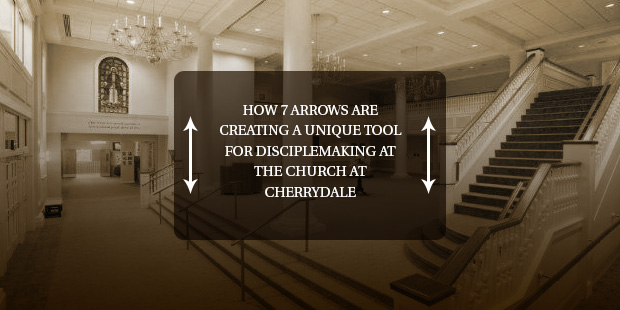
How 7 Arrows Are Creating a Unique Tool for Disciplemaking at The Church at Cherryvale
There is often a vast disconnect between the awareness of the need for disciple-making and practical tools that actually aid in this work. Three factors are essential: Scripture, relationships, and time. Discipleship happens when the life-changing truth of Scripture is infused into genuine relationships over an extended period of time.
Our desire was to create a simple, reproducible strategy that would facilitate this process. This led us to develop a simply strategy for small clusters (2-3 people) to meet together regularly and talk about the Scriptures and apply them to their lives.
The seven arrows of Bible reading were an attempt at developing a tool for proper hermeneutics to power these relationships. We did not want our people to simply talk about the Bible. We wanted them to understand the Bible and know how to apply it to their lives. Each cluster would read a predetermined passage of Scripture and discuss it using these seven arrows.
The goal was for the clusters to start by summarizing the main point of the passage as succinctly as possible, ideally in one sentence.
Next, the clusters sought to discern authorial intent for the passage by asking what it meant to its original audience. Since a text of Scripture can never mean what it never meant, it is necessary to begin by discerning what the text meant. Often this may require the clusters to consult other study tools or cross-reference other Biblical texts to arrive at the meaning of the text.
Thirdly, we asked what the text tells us about the nature and character of God and specifically His work through the person and work of Jesus Christ.
Fourthly, the text was analyzed to see what it tells us about humanity. Bryan Chappell refers to this as the “fallen condition focus” of the text. What does the text reveal about sin and mankind’s need for the gospel?
Then we moved the clusters to application. Since we had now rooted the clusters in the meaning of the text, they were now positioned to rightly apply it’s meaning to their lives.
From there we wanted our clusters to apply the Scripture to their relationships with others. Ideally, they would discuss how the text shaped both how they related to other believers and how they lived on mission in the world.
Finally, the clusters rooted their prayers in the Scriptures. Hopefully, the previous six arrows kindled the flames of passionate prayer in the lives of the clusters – both for their own sanctification and for their mission to the lost.
With these model, we touched on three important areas for discipleship:
- Scripture – Disciple-making was rooted in a rightful understanding of Scripture and not in simply doing life together, unpacking another sermon, or dependance on classroom instruction.
- Simplicity – Disciple-making was simple enough for everyone to get involved. All believers could take these principles, a Bible, and a relationship with a young Christian and get to work.
- Stickiness – Disciple-making through understanding and applying Scripture was etched in the minds of our young church. They could use these same arrows to not only guide their cluster discussions, but also their personal Bible Study, small group leadership, and comprehension of sermons.
To further encourage and aid our people, we gave them bookmarks with the seven arrows on them. These arrows have proven to be a unique tool in our disciple-making toolbox that the Lord is using to call and build faithful and fruitful followers of Jesus.
Read more from Matt here.

Tags: Connect, Discipleship, Matt Rogers, Tools



















